The Next Leap Forward and the Library Mindset
Generative AI will transform library work. What can past upheavals teach us about how to find our way forward?

Generative AI will transform library work. What can past upheavals teach us about how to find our way forward?
In 1994, I was working as a junior librarian in the serials department of a university library, my first professional job. One day, I came across a new technology that presented journal articles in a format called “PDF.” I told my supervisor, an experienced serials librarian. I don’t remember her reaction to this novelty, but it must have impressed her enough that she told the associate university librarian, who came to my desk not long after to see it herself.
To working librarians at that time, who were used to physical library collections and analogue communication, the swiftly emerging technologies that enabled electronic publishing, digital communication, and file transfer via the Internet and the World Wide Web must have required a leap not only in practice, but in mindset.
In the 30 years since, challenges have arrived in waves. Continuously evolving formats affect the ways we manage collections and provide access. The Web made information abundant and accessible, pushing librarians to shift or widen traditional information services from a “reference help” model to teaching information literacy.
Now Generative AI is rocking our boat. Libraries are already answering information queries with chatbots, helping researchers use AI tools for literature search, and teaching about AI literacy. Most academic librarians would agree that more changes will come.
Instead of trying to forecast how this might happen, I look back on my three decades of work in the field to see how my experience of previous upheavals might help us all find some bearing.
Over the last 30 years, when my colleagues and I felt lost and frustrated in the course of navigating major changes, one question guided us: “What new services will enable our users in their academic pursuits?” To respond to this question, we typically did two things:
1. We got to know our users’ academic daily lives and needs while examining our own assumptions about library service models.
2. We took on hard learning and experimentation, individually and collectively.
This process led to conceptual changes in our service models and service philosophy, which sometimes challenged the traditional service scope of libraries, but ultimately helped the library deliver its value in the new technological and academic landscape.
Two stories of change illustrate my points.
The Hong Kong University of Science and Technology (HKUST), founded in 1991, is a young and energetic research-intensive university in Hong Kong. It has about 17,000 students and over 800 faculty members.
HKUST Library opened its Information Commons (IC)—a zone with high-end computing facilities to support students’ work—in 2006 and its Learning Commons (LC)—a collaborative learning space—in 2012. I was a reference librarian then, but the university librarian asked me to coordinate the operations of both commons.
 CREDIT: HKUST
CREDIT: HKUST
In 2024, integrated technology in library spaces is taken for granted. It is hard for many of us to imagine studying and working without portable devices and Wi-Fi connection. Now, let us flash back to the early 2000s. In my library, seats and tables were arranged in rectangular rows intended for individuals’ self-study in a mostly offline, quiet mode. Personal laptops were not yet ubiquitous. Computers in the library were “OPACs,” terminals for accessing the library catalogue and networked databases. Productivity software was intentionally disabled so that users could not occupy OPAC stations for purposes other than searching for information.
“Information commons” was a service model that provided users with a technology-rich learning environment. To transition from a status quo in which we confined computing facilities to the access of library resources to one in which we offered users a wide range of software for their academic needs required that we wholly reenvision our information services and technology support.
To plan for the renovation and new services, our library formed a taskforce, of which I was a member. We learned from the library literature about the IC concept and studied libraries that had renovated their spaces with technology, including the University of Toronto, Northwestern University, and Glasgow Caledonian University. We realized that students’ learning was becoming more embedded in a computer environment and that the IC could better serve our students by bringing library services and reference help into their workflow.
In 2006, we removed one-third of the reference collection to make space for the IC, which had 50 computers and a variety of furniture settings: high and low tables, individual seats, and round tables for groups. We provided network printing, scanning, productivity and media editing software, and a new technical help desk.
The IC opened as a pilot that September. Usage data and a 2007 satisfaction survey indicated its success. In 2009, we expanded the IC with more group seating and software.
During the planning phase in 2006, some colleagues expressed doubts about the library providing productivity software and computing equipment; during our 2009 expansion, no one voiced such concerns. Apparently, we had all made the mindset leap to new ways of delivering old library value.
A few years later, in 2012, we opened the LC, a 24-7 collaborative learning space. Despite my experience setting up the IC, I did not have a clear picture of what a “collaborative learning space” would look like. To me, as to many of my colleagues, study seats were for studying. Other pursuits—like leisure gathering and extra-curricular activities—were not only unwelcome but forbidden. We were stepping into an unknown territory.
We began to explore and experiment. We visited student amenities, campus IT, and media production support, seeking to understand students’ experiences on campus and to explore service gaps and identify potential service partners. Based on those conversations, we designed spaces for group work, refreshment, and media production. After we opened the LC, we invited representatives of academic units and various offices to visit and asked how the library could help them conduct activities in the space.
The effort we made to develop a sense of our users’ needs and shape our support accordingly paid off. The LC opened in February 2012 with a full slate of programs, including a math tutorial center, mock job interviews, counselling, and academic advising. The library had transformed from a static study space to a true partner in teaching and learning.
In 2018, my library director asked me to direct a new initiative to develop research data management (RDM) services. I had no confidence that I could do it.
As early as 2008, I had proposed archiving our university’s research data in our institutional repository. But my vision of how a library might support the management of research data did not grow beyond that repository concept. We established a separate data repository in 2016, but the uptake was slow.
Now, I was concerned about our capacity and competencies. The project imposed a steeper learning curve than other service changes I had managed, calling for computational data skills and an understanding of data issues in the research cycle. I did not know how to start or who could help me. I also felt unsure about what roles my team and I could play and what the service would look like.
But I understood that research data was soon going to be a key component of research support service in academic libraries.
We undertook a learning journey, both as individual librarians and collectively as a team. Over the course of two years, I organized training programs and peer learning activities for interested HKUST librarians. At the same time, our research support team librarians attended conferences and webinars. We held an in-house program in 2021/22 to consolidate our learning about writing data management plans. We organized webinars by guest speakers for researchers as well as librarians. We developed research management workshops for research students—after all, teaching is the best way to learn something new. We conducted focus groups with researchers to learn about their data practices.
On the infrastructure side, in 2019, we experimented with a platform to store data management plans. In 2021, we decided to adopt DMPTools, which had better features and a wider user community.
I achieved my own mindset leap in RDM services incidentally. In 2018 and 2019, I was finishing my doctoral study in academic librarians’ leadership development. It was a qualitative study; my research included survey data, interview recordings, and transcripts. My personal experience as a researcher helped me appreciate data issues: the way data could evolve in a research cycle, versioning, privacy, curation, and long-term preservation. I shared my enriched understanding of research data services with my team.
We had once thought that handling data was purely the researchers’ own responsibility, but when we started to see what a library could do to support researchers’ workflow, our service model concept evolved. In 2020 and 2021, when two new librarians joined us with keen interest and skills in research data, our RDM workshops for researchers picked up in scope and quality. Our new colleagues also energized the peer learning dynamics within the team.
Today, in 2024, our services have two key components: the infrastructure, consisting of a data repository and a data management plan platform; and user education via a portfolio of workshops and online guides for researchers. We are working toward offering in-person assistance in 2024/25 academic year.
Our collective growth continues.
Academic librarians reinvent our service models whenever necessary. We change the service content (what we do), or the way we deliver services (how we do it). But what remains constant is the library value to users (why we do it).
The two stories I shared here are not meant to be success stories. On the contrary, I would like to emphasize how often we were clueless when we embarked on something new. With hindsight, we tend to forget how lost we were and what things were like before we achieved that mindset leap to new service models.
Facing Generative AI, I am clueless yet again. How the technology will affect academic lives in universities is not yet clear. I cannot describe with certainty what library services will look like in three years. I don’t yet know how to help my team to prepare for the changes. But we are learning and experimenting, and, ultimately, we are going to find new ways to do the same job: enable our users in their academic pursuits. When a new service mindset emerges on our horizon, we will be eager to take the leap.
10.1146/katina-20240801-1
Copyright © 2025 by the author(s).
This work is licensed under a Creative Commons Attribution Noncommerical 4.0 International License, which permits use, distribution, and reproduction in any medium for noncommercial purposes, provided the original author and source are credited. See credit lines of images or other third-party material in this article for license information.